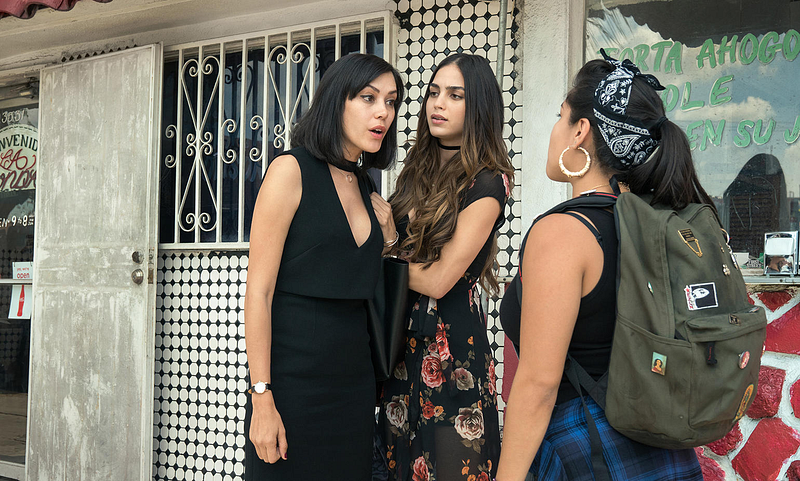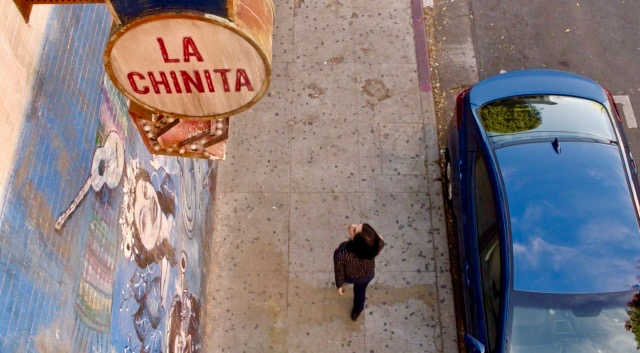The second season of “Vida”is available to stream on the Starz app Thursday, May 23 with episodes airing weekly on the Starz network starting Sunday, May 26. The first season is available now on Starz and via the Hulu add-on. Warning: spoilers ahead.
The second season of Starz’ Vida is out this week and I’m so excited. If you missed the first season (because it’s on Starz, because you didn’t even hear about it because it’s on Starz), Vida is the millennial/Latina/queer show of our dreams.
It follows two Chicana sisters, Emma and Lyn Hernandez, who return home to Boyle Heights to bury their mother and decide what to do with the family business, a neighborhood apartment building and bar. Emma is the career-driven chingona, taking charge and ruffling feathers everywhere she goes. She also happens to be a lesbian. Lyn, meanwhile, is all drifting free spirit. She moves from man to man, business idea to business idea, with her good looks, overall cool, and loose morals (stealing a credit card in her deceased and debt-laden mother’s name — yikes) to live well beyond her means.
Soon, Emma and Lyn realize that not only is the bar/building vastly underwater with bills owed to greedy gentrifiers but their mother was married to her female “roommate” Eddy despite not even being out to her daughters. Newly widowed, Eddy has one-third share of the family business with the rest split between Lyn and Emma. Together, this unlikely trio has to figure out a way forward.
Created and led by Latinas, Vida’s baked latinidad into its every fiber and the results are amazing. There’s the all Latinx cast. The Boyle Heights setting. And there’s the way Vida truly centers family, identity, and a nuanced conversation about gentrification.
Created and led by Latinas, Vida’s baked latinidad into its every fiber and the results are amazing. There’s the all Latinx cast. The Boyle Heights setting. And there’s the way Vida truly centers family, identity, and a nuanced conversation about gentrification. The first season manages all this deftly, making Vidaread as an edgy, critical darling while being firmly rooted in the Latinx experience.
I particularly appreciated seeing Emma and Lyn navigate their identities in response to the question so many of us grapple with: are you Latina enough? Emma spends the first season confronting the idea that she hates where she’s from with several characters stating or implying as much. The truth is, Emma doesn’t hate Boyle Heights — she’s just estranged from it as her mother sent her away in a (failed) effort to stop Emma’s queerness. This rejection led Emma to build walls against her loved ones and her home. Yes, despite her prickliness, Emma learned formal Spanish, ensuring her ability to communicate in the neighborhood. And while her initial instinct is to sell the bar, she ends up picking another path. She figures out the predatory nature of the loans her mother took out and that selling would mean letting those folks win, so she decides to stay and use her college-educated business acumen to make the place profitable. Emma’s straddling two (three? multiple?) worlds and trying to figure out what pride in her identity means while also dealing with self-loathing as a rejected and isolated daughter.

You see, Vida doesn’t just have latinidad at its core, it’s also dealing with female sexuality in its many forms. There was A LOT of sex in the first season with Lyn and Emma each having multiple partners, plus a prolonged solo scene. And since this is Starz, yes, those scenes were erotic as hell. But take note — they didn’t rely on the usual male-gaze tropes of depicting women as objects. Instead, I saw sex scene after sex scene with different sets of participants (woman/man, woman/woman, woman alone), all centering female pleasure and the woman’s perspective. It was hot. And this rare, woman-focused depiction of women’s sexuality is made even more powerful by how it centers and values brown bodies not as sites of sexual gratification but as agents deserving of love and pleasure.
Building upon its depiction of sex and brown identity, Vida uses gentrification as its looming threat, powering the plot. Gentrification’s the reason Emma and Lyn stay in Boyle Heights instead of returning to their lives in Chicago and San Francisco after the funeral. It’s the reason Eddy isn’t able to be forthright about the books at the beginning and it lays the groundwork for her ending up in the hospital at the end. And, of course, it’s the menace Marisol and her group of activists are working against, a battle that puts her in conflict with the sisters.
This rare, woman-focused depiction of women’s sexuality is made even more powerful by how it centers and values brown bodies not as sites of sexual gratification but as agents deserving of love and pleasure.
Gentrification threatens all of Boyle Heights. For Emma, the conundrum is if you need to charge $8 a drink to pay your rent then you can’t stay a neighborhood place. But if you don’t charge that amount and lose your property, the next place that opens won’t cater to the original residence either. For the residence, it’s what’s pushing them out of their homes and wreaking havoc on their community. For the activist group, it’s how to hold back the tide of economic “development” that’s destroying the neighborhood and, to push the tide metaphor, like water always seems to find a way.
In other shows with big external threats, there’s often a clear answer. Is it war or monsters that threaten you? Then fight for your life. Kill your enemies and create your own bit of peace. Think Walking Dead, Lord of the Rings, even Mash. Is it a natural (or supernatural) disaster? Perhaps surviving is enough. Gather the people you love and try to make it like Viggo Mortenson in The Road or Helen Hunt in Twister.But what if you’re facing gentrification? Putting one developer out of business won’t end the threat, no matter how slimy and terrible they are. Surviving may mean moving, which here means defeat.

The first season of Vida setup gentrification as the show’s primary danger, exploring the ways it works and why it’s so intractable. I’m excited for the second season to delve into solutions as Emma, Lyn, and Eddy work to save the bar. The answers aren’t clear but I hope we see them join Marisol and try to overthrow the system. I can’t imagine Emma tagging anything or either of the sisters marching in a protest (although I could see Eddy taking to the street). No, I envision Emma meeting with city council members to change laws while Lyn uses her charm to get the intel needed. Perhaps, working together, these women can push on all the levers needed to save Boyle Heights for its residents and for us. I’ll certainly be tuning into the second season to find out.
And even if we can’t find the solutions to gentrification in the show, Vida is doing its part in the real world. You see, the problem at the heart of gentrification is that the market and American culture at large don’t value actual Latinos. They want our food and our art and our labor but not our humanity. In fact, they don’t even see us. When compared to our numbers in the general population, Latinx are the least represented group on screen. And when we do show up, we’re usually criminals and drug runners. This is the country that elected Donald “Mexicans-are-rapists” Trump as President.
In its way, just by existing, Vida is helping to right these wrongs, displaying Latinas as the beautiful, complicated, fully human people we are. And it’s doing so in a way that appeals to the hipsters who wrote off One Day at A Timeand Jane the Virgin as too fluffy, inconsequential, or not for them. Take note and join me in watching, evangelizing and generally not shutting up about season two.
The problem at the heart of gentrification is that the market and American culture at large don’t value actional Latinos. They want our food and our art and our labor but not our humanity… Vida is helping to right these wrongs, displaying Latinas as the beautiful, complicated, fully human people we are.

